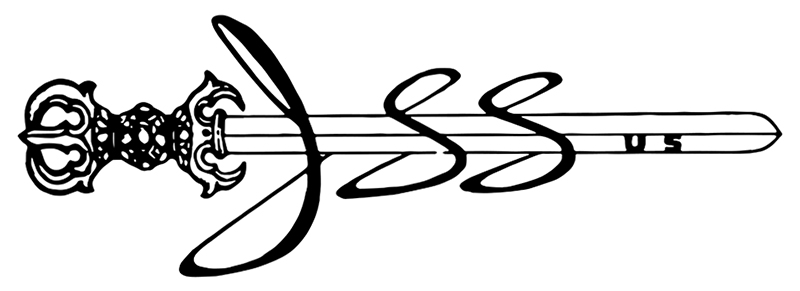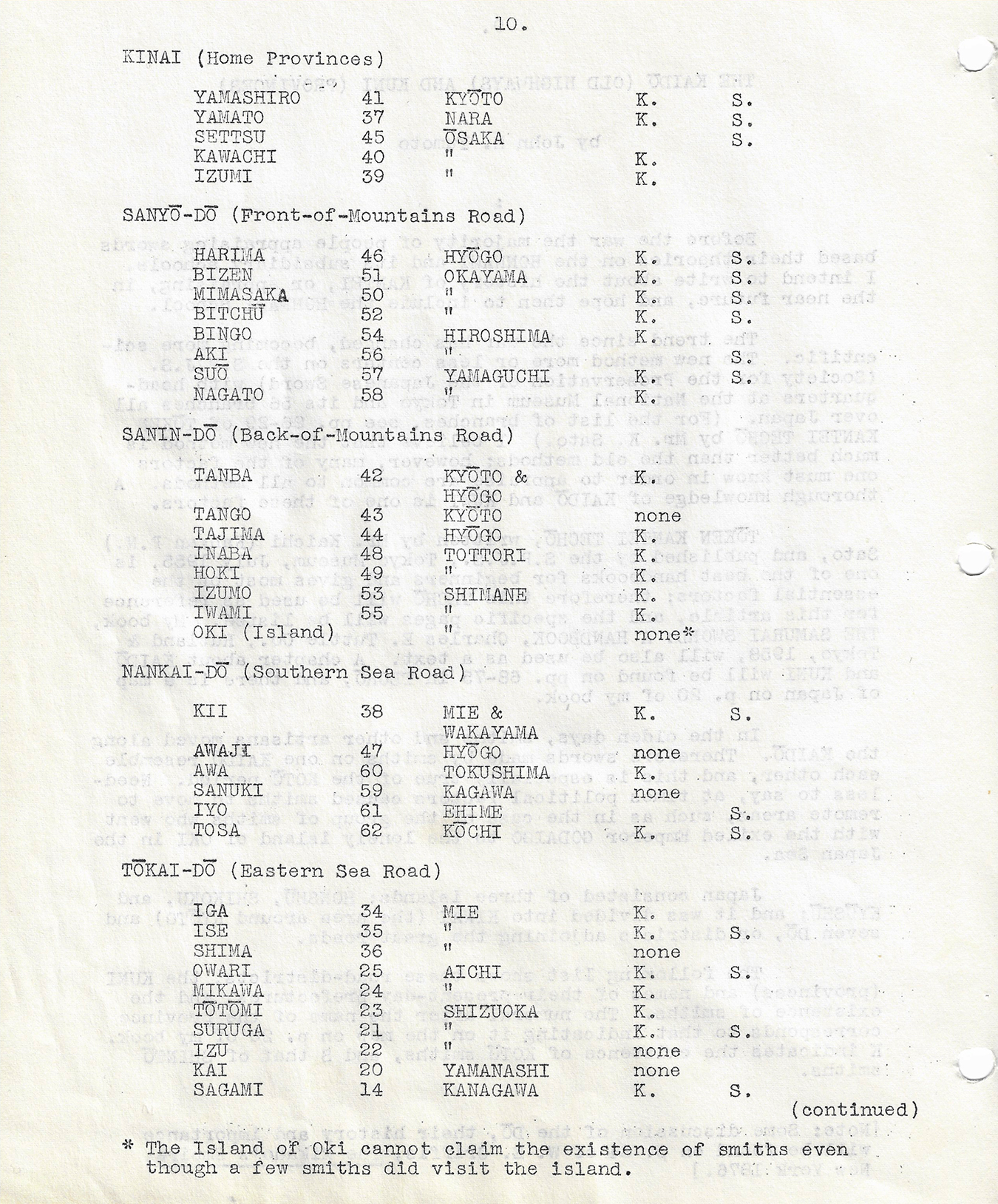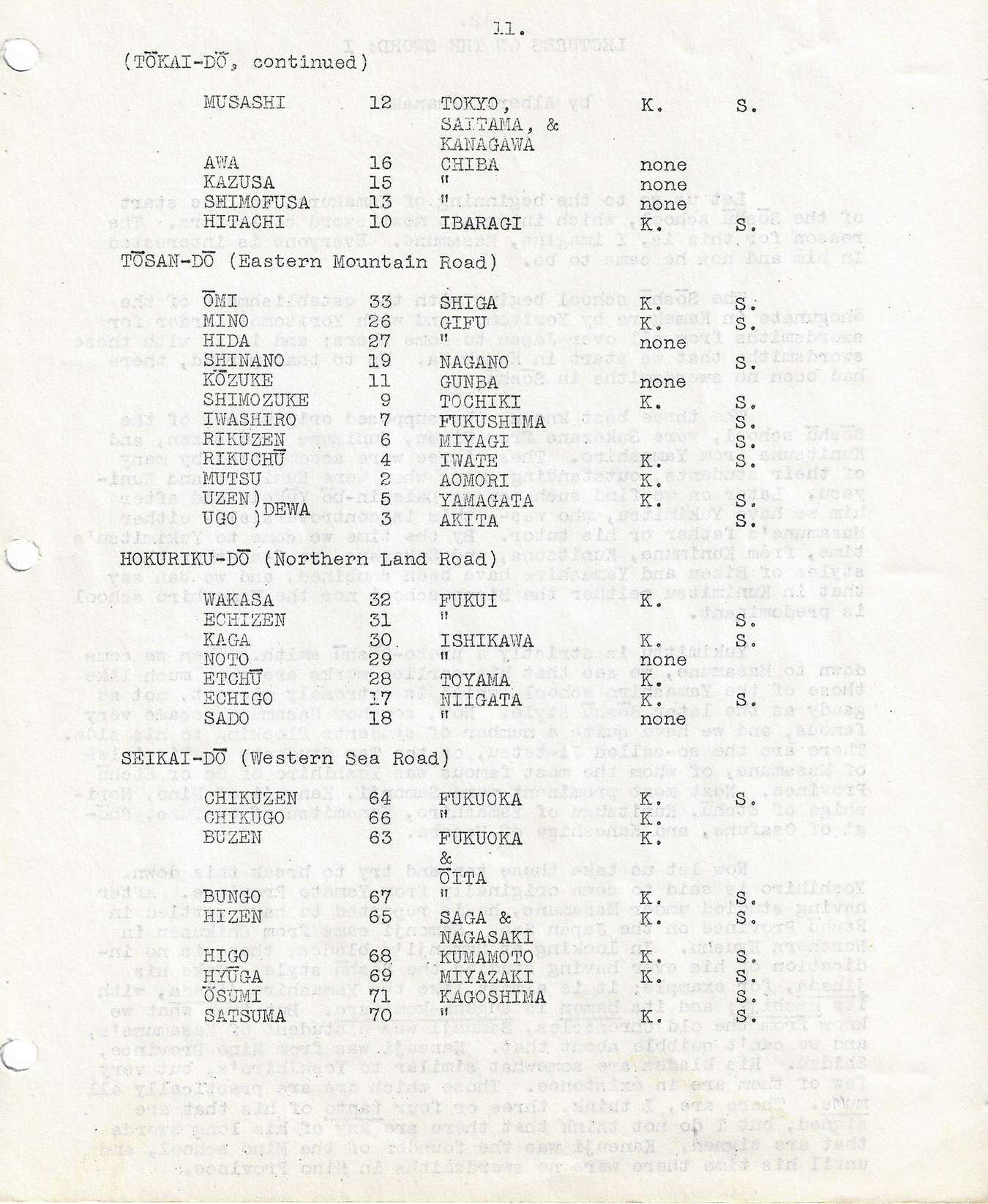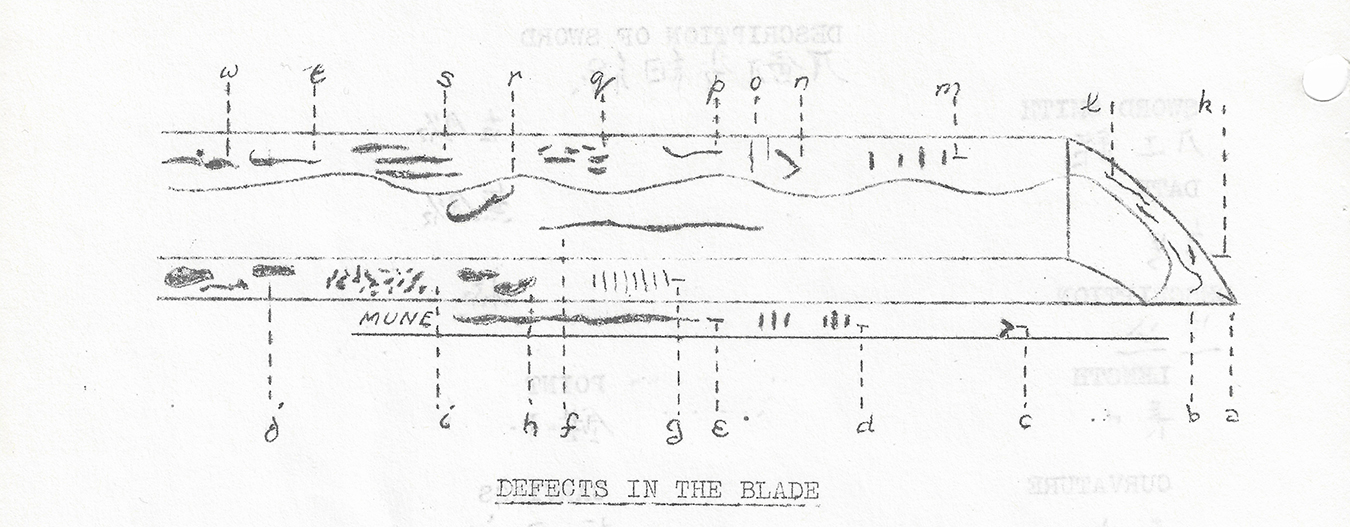
The articles on this page originally appeared in JSSUS newsletter Volume 1 no.1 1959.
Retrospect and Prospect - Page 1
Juyo Token Nado Zufu, Index, translated by John M. Yumoto - Page 5
The Kaido (old Highways) and Kuni (Provinces) by John M. Yumoto - Page 9
Lectures on the Sword: I, by Albert Yamanaka - Page 12
Flaws in Sword Blades (diagram from Joly) - Page 16
Copyright 1959, Japanese Sword Society of the United States
Vol 1 Number 1 1959
RETROSPECT AND PROSPECT
The Japanese Sword Society of the United States was founded, a little over a year ago, by Bryce Brooks, Jack Paras, Paul Allman, and Reginald Bretnor. Its aims were then defined (as they are set forth in the Constitution which forms part of this Bulletin,) and a basic program was agreed upon. This program consisted, first, of the local activities of the Society (general meetings and more formal seminars,) and, secondly, of activities on a wider scale. It included plans for expanding the membership of the Society throughout the United States, for establishing liaison with Japanese scholars and collectors of the sword, and for the publication, not only of the Bulletin, but also, eventually, of more ambitious works either in translation from the Japanese or newly-written in English.
A functioning organization must have direction, and so we elected the following officers pro-tem: President, Reginald Brotnor; Vice-President, Jack Paras: Secretary-Treasurer, Paul Allman; Corresponding Secretary, Bryce Brooks. Shortly after the Society's formation, Leonard O Hart and Richard C. Knight were elected to membership, and since that time the membership has grown to a total of fourteen, in all parts of the United States. Since then, too, we have adopted a Constitution, which we are now presenting for the consideration and approval of the membership. This Constitution is essentially identical with the very concise and practical statutes of the old Japan Society of London, but with such changes as necessary in the light of national differences and of our more restricted field of interest. We hope that members will consider the Constitution carefully, and that they will send us their comment and their criticism.
In addition to presenting the Constitution, the officers pro-tem, acting as a nominating committee, suggest the following candidates for the Board of Directors which the Constitution calls for: Chairman, Reginald Bretnor; Vice-Chairman, Paul W. Allman; Secretary Treasurer, Brice Brooks. It is nor our Intention that the San Francisco Bay Area should permanently monopolize all the executive offices of the Society. We feel, however, that at least for the time being it is more practical for these offices to remain here, especially because our program for the future so greatly depends on the generous guidance and assistance of John M. Yumoto, who is acting as our sensel, and of Albert Yamanaka, who so often gives us the benefit of his extensive knowledge and experience.
Mr. Yumoto is the author of The Samurai Sword, A Handbook, published last year by the Charles E. Tuttle co., Rutland, Vermont, and Tokyo. A native of California, he went to Japan as a boy and studied not only the judging of swords, but polishing and forging blades as well. He represents the new school of sword appraisal, led by Dr. Junji Honma and Dr. Kanza Sato, and "is perhaps the foremost authority on the samurai sword outside of Japan." He has given us a great deal of his time, attending seminars, lecturing, making tapes for transcription, and helping us plan our course for the future. A glance at the contents of this first issue of the Bulletin, and at the list of projects already planned, will give members some idea of the extent of our debt to him. Mr. Yamanaka's authority as a sword expert derives from the traditional Honnami school of sword appraisal, in its perfected modern form developed by Honnmi Koson, from whom he learned the art. Mr. Yamanaka, under the nom-do-plume of Kosan, is a qualified sword appraiser. He too has been most generous with his time and his counsel, and the Society already owes much to him.
Our plans for the immediate future include, first, the publication and distribution of this Volume One, number One of the Bulletin. Copies will be sent to all the members, to all museums which may conceivably be interested, to universities where (as at the University of California) emphasis has been placed on East Asiatic studies and libraries, and to individuals and institutions interested in closely allied fields. (In thin connection, members are requested to send the Secretary the name and address of anyone to whom they think a sample copy of the Bulletin should go.) At present, while we would like to promise a quarterly Bulletin, we find that we cannot do so honestly, and therefore will confine ourselver to assuring the membership of at least two a year, with occasional newsletters to fill in with.
Our translation program, on which Mr. Yumoto is already working, includes the following:
1. Gyobutsu Tohaku Mei To Oshigata Shi, by Dr. Kanzan Sato (Imperial Household Treasures from the Tokyo Museum Famous Sword Rubbing Collection,) pp. [8], [11-367. [2], 14.25" x 10", illustrating 242 Koto and 68 shinto. This great work, by the kind permission of the author, will be translated and edited with notes by Mr. Yumoto. (The Japanese text is available from the society for $14.30 for members and $18.20 for non-members, postage extra. The translation will be furnished in parts as it is completed, either at no extra charge or, if this becomes necessary, a nominal charge to cover the cost of paper and reproduction.).
2. Juyo Token Nado Zufu, (Photographs of Important Sword and Related objects,) No. 1, June 5, 1958, compiled by Susumma Keshima, pp. (64), 12" x 8.5". Mr. Kashima is the son of Mr. Isso Kashima, for thirty years president of the Osaka Token Club, and is with the Sword Department of the National Museum. Through his kind cooperation, the rights of English translation have been granted to Mr. Yumoto. (This work, the beginning of a series, is available from the Society for $2.75 to members and $3.50 to non-members. It illustrates and discusses twenty-six blades, a complete tachi Koshirae, and several Tsuba, all of which fall into the second category of important art objects ranking just below the class of National Treasures.)
3. Tagane 0 Tazunete (The Search for the Chisel,) Nos. 1-6, with the title subsequently changed to Tagana (Chisel.) This periodical publication is put out by Mr. Takumi Yokoyama of Seto, Okayama, Japan, who has been so good as to give Mr. Yumoto permission to translate it into English. (The first six numbers are available from the Society for $2.75 to members and $3.50 to non-members, posatago extra, with additional numbers at the same rate as they appear.) The publication deals primarily with sword furniture.
In addition to the Bulletin and the translations, it is our intention eventually to make available to the membership, either directly through the Society or through the agency of some Japanese dealer in the United States working with the Society, those supplies and services which are necessary to the preservation of swords and to the restoration of those which need it. Certain of these supplies-- notably kits for the care of swords, sageo, and tassels for sword bags can now be obtained from Mr. K. Yamashita, Oakland, California. The local membership of the Society, together with some from out of town, owe a debt of gratitude to Mr. Yamashita, who has been unfailingly helpful to all who are interested in the sword.
We also intend, at some time in the future, to set up awards for the encouragement of those swordsmiths still practicing their art in Japan, and to assist craftsmen in associated fields such as making and wrapping tsuka, scabbard making, and lacquering. We would very much like, eventually, to bring a first class polisher over from Japan for a couple of years; we can do this by guaranteeing him enough blades to polish at a reasonable figure. Finally, some day we hope to be able to arrange a sword tour of Japan conducted by John M. Yumoto, an arrangement which would make it possible for those participating to see many of the really great blades.
In the meantime, we would appreciate advice and suggestions from all our members, as well as from all collectors and students of the sword who are now hearing of the Society for the first time. We would be especially pleased to hear from all those who either plan to contribute notes or articles to the Bulletin or who can help us in some of the essential chores-- such as cutting stencils. So let us hear from you.
R. Bretnor
President pro-tem.
NOTES AND COMMENTS
DUES: Because of the fact that the Society issued no publications during 1958, and was otherwise inactive so far as members not In the San Francisco Bay Area were concerned, the officers pro-tem have extended all memberships for another year. - Therefore members who are paid up for 1958 need pay no dues for 1959.
MEMBERSHIP CARDS: Membership cards are now being prepared and will be mailed to members when ready.
VISITING MEMBERS: Members planning to visit the San Francisco Bay Area are urged to notify the Secretary well in advance of their arrival so that appropriate plans may be made to introduce them to local members.
SWORD JUDGMENT or KANTEI: Mr. John M. Yumoto has generously offered to judge swords for members. Each member is entitled to have one sword judged without fee every year. The sword should be sent to the Secretary, Japanese Sword Society of the United d States, P.0. Box xxxxx California, and the member should pay postage both ways, remitting return postage in his covering letter to cut down paper work. If more than one sword is sent in by a member in any one year, the subsequent ff Judgments will be charged for at the rate of $3.00 per sword, the fee going into the Society's treasury. APPLICATIONS FOR MEMBERSHIP: The use of an application for membership is not necessary. However, we are including blanks with this Bulletin as time savers for those who want them, or for passing along to prospective members.
THE KAIDO (OLD HIGHWAYS) AND KUNI (PROVINCES)
by John M. Yumoto
Before the war the majority of people appraising swords based their theories on the HONMAMI and its subsidiary schools. I intend to write about the history of KANTEI, or appraising, in the near future, and hope then to include the HONAMI School.
The trend since the war has changed, becoming more scientific. The new method more or less centers on the S.P.J.S. (Society for the Preservation of the Japanese Sword) with headquarters at the National Museum in Tokyo and its 56 branches all over Japan. (For the list of branches, see pp. 26-29 of TOKEN KANTEI TECHO by Mr. K. Sato.) I believe that the new method is much better than the old methods; however, many of the factors one must know in order to appraise are common to all methods. A thorough knowledge of KAIDO and KUNI is one of these factors.
TOKEN KANTEI TECHO, written by Mr. Kaichi (Kanzan P.N.) Sato, and published by the S.P.J.S., Tokyo Museum, July 1955, is one of the best handbooks for beginners and gives most of the essential factors; therefore this TECHO will be used as reference for this article, and the specific pages will be listed. My book, THE SAMURAI SWORD: A HANDBOOK, Charles E. Tuttle Co., Rutland & Tokyo, 1958, will also be used as a text. A chapter about KAIDO and KUNI will be found on pp. 68-75 in TECHO, and there is a map of Japan on p. 20 of my book.
In the olden days, smiths and other artisans moved along the KAIDO. Therefore swords made by smiths on one KAIDO resemble each other, and this is especially true of the KOTC period. Needless to say, at times political factors caused smiths to move to remote areas, such as in the case of the group of smiths who went with the exiled Emperor GODAIGO to the lonely island of OKI in the Japan Sea.
Japan consisted of three islands: HONSHU, SHIKOKU, and KYUSHU; and it was divided into KINAI (the area around KYOTO) and seven DO, or districts adjoining the great roads.
The following list shows these road-districts, the KUNI (provinces) and names of their present-day prefectures, and the existence of smiths. The numeral after the name of the province corresponds to that indicating it on the map on p. 20 of my book. K indicates the existence of KOTO smiths, and S that of SHINTO smiths.
[Note: Some discussion of the DO, their history and importance will be found on p. 84 of W. E. Griffis, The Mikado's Empire, New York 1876.] Scans of Page 10 and 11


LECTURES ON THE SWORD: I
by Albert Yamanaka
Let us go to the beginning of Kamakura, and the start of the Soshu school, which interests most sword collectors. The reason for this is, I imagine, Masamune. Everyone is interested in him and how he came to be.
The Soshu school begins with the establishment of the Shogunate in Kamakura by Yoritomo, and with Yoritomo's order for swordsmiths from all over Japan to come there; and it is with these swordsmiths that we start in Kamakura. Up to that period, there had been no swordsmiths in Soshu. The three best known, the supposed originators of the Soshi school, were Sukezane from Bizen, Kunimune from Bizen, and Kunitsuna from Yamashiro. These three were accompanied by many of their students, outstanding among whom were Kunihiro and Kuniyasu. Later on we find such men as Daishin-bo Yuke, and after him we have Yukimitsu, who was-- this is controversial-- either Masamune's father or his tutor. By the time we come to Yukimitsu's time, from Kunimune, Kunitsuna, and Sukezane, we find that the styles of Bizen and Yamashiro have been combined, and we can say that in Kunimitsu neither the Bizen school nor the Yamashiro school is predominant.
Yukimitsu is strictly a proto-Soshu smith. When we come down to Masamune, we see that his earlier works are very much like those of the Yamashiro school, which is extremely elegant, not as gaudy as the later Soshi style. Now, somehow Masamune became very famous, and we have quite a number of students flocking to his side. There are the so-called Ji-tetsu, or the Ten Students or Disciples of Masamune, of whom the most famous was Yoshihiro of Go or Etchu Province. Next most prominent were Samonji, Kaneuji of Mino, Norishige of Etchu, Kunitsugu of Yamashiro, Kanemitsu of Osafune, Chogi of Osafune, and Kaneshige of Hasebe.
Now let us take these ten and try to break this down. Yoshihiro is said to come originally from Yamato Province. After having studied under Masamune, he is reported to have settled in Etchu Province on the Japan Sea. Samonji came from Chikuzen in Northern Kyushu. In looking at Samonji's blades, there is no indication of his ever having studied the Soshu style. Take his jihada, for example; it is almost like the Yamashiro Jihada, with its nashiji; and its hamon is suguha-komidare. But from what we know from the old Chronicles, Samonji was a student of Masamune's, and we can't quibble about that. Kaneuji was from Mino Province, Shizu. His blades are somewhat similar to Yoshihiro's, but very few of them are in existence. Those which are are practically all mumei. There are, I think, three or four tanto of his that are signed, but I do not think that there are any of his long swords that are signed. Kaneuji was the founder of the Mino school, and until his time there were no swordsmiths in Mino Province.
After Kaneuji, the work deteriorates quite a bit. Norishige was from the same province as Yoshihiro, Etchu. The main characteristic of his blades is that in the jihads is found the so-called matsukawa-hada, which is translated as pine tree grain or bark. Most of Norishige's work was in tanto; I do not think that there are any long swords of his in existence.
Rai Kunitsugu of Yamashiro was one of the Rai school boys. The first of the school was Kuniyuki who supposedly emigrated from Korea as a swordsmith, and started a school in Kyoto, After Rai Kuniyuki, there was Kunitoshi. Thore were two Kunitoshi, the Ni-Ji Kunitoshi and the Rai Kunitoahi. One signed his swords with the two-character Kunitoshi, and the other signed Rai Kunitoshi. Here again we find controversies, some saying that they were separate men, and others saying that they were the same man and that their work was very similar, practically identical. Ral Kunitsugu was either a student or son of Kunimitsu.
Going into Bizen, we have Kanemitsu, who is, I think, the best-known or the most popular of the Ji-tetsu. There are a number of Kanemitsu's works still in existence, many of them signed. He made a lot of tanto as well as long swords. Now, Kanemitsu was of the Osanfune school. However, because he studied under Masamune, he more or less established his own style in the blade pattern, some of the characteristics of which derive from his father, Kagemitsu. But, because of the fact that he studied with Masamune, nie were introduced into the Bizen sword at this time. With Chogi, this is very much more prominent than in Kanemitsu.
Hasebe Kunishige is not as well known, as is the case with Sekishu Naotsuna. Kenjuo Kaneshige was also of Mino Province, with a pattern typical of the Mino style seen in Shizu Kaneuj.
Now, aside from these ten, Masamune had another student, who later became his adopted son: Sadamune. Sadamune's work is more hade-- flashy, gaudy-- in the blade pattern, and in the shape of the blade itself too. Between Sadamune and Masamune there was not much time difference, but there is something odd here. Most of Masamune's tanto are very short. In a few of his so-called Hocho Masamune, the blade is very wide, but they are not long. But when you come to Sadamune, all of a sudden the tanto blade becomes very long. It goes up to about one shaku, four-five sun, as in the case of the Tokuzen-in Sadamune; this is a National Treasure, and is one shaku, one sun. Most of the Masamune tanto are nana-sun, hachi-sun. So we can say that the swordsmiths succeeding Sadamune produced the real Soshu style blades, because after Sadamune we have Hiromitsu, Akihiro, Akimitsu, and so on, whose pattern of work is rather similar to Sadamune's, but much inferior in workmanship. In the succeeding products of the Soshu school, the blade pattern gets gaudier and gaudier, and towards the end the whole blade is covered with hitatsura.
Now, going back to Sadamune, he too had a number of students, among whom the three most prominent were Nobukuni of Yamashiro, Motoshige of Bizen, and Kunimitsu of Tajima, otherwise known as Hojoji Kunimitsu.
Other than these, as I said, the Soshu school goes through Akihiro, Hiroaki, and so on. However, by that time the Minamoto or Kamakura Shogunate had ended, taken over by the Ashikaga Shogunate, so that the Bakufu was in the hands of the Ashikaga fantly and no longer in Kamakura, and that just about ended the Soshu school. Succeeding students of Akihiro, Hiroaki, etc. tried to continue their work in Soshu, but the movement of the Bakufu had shifted the center of patronage elsewhere.
[Q: What is the difference between the Mino and Seki schools? A: The Mino school was the original school established by Kaneuji. When you say "Seki school," that refers to the followers of later generation smiths, of names starting with Kane, well into the Sengoku Period. After Kaneuji, about the only prominent swordsmith is Kanesada... There are a few like Kanemoto Magoroku; and Muramasa is also an offshoot of Seki, but Muramasa and Kanemoto are not true Mino style swordsmiths.]
NOTES ON POLISHING:
There are a couple of members who are interested in the polishing of the sword. With the help of Mr. Yunoto, who studied polishing in Japan, I have been making a little study of polishing and of the stones used by Japanese polishora.
The literature has universally stated that limestone was used. Through the kind assistance of Dr. Charles Meyer of the Department of Geology at the University of California, an X-ray diffraction analysis of three polishing stones was made. The first was a specimen of rather hard uchirgomori, the last stone used in polishing. This proved to contain 10% to 20% muscovite or white mica, less than 5% alkali feldspar, 50 to 60% quartz or silica and only 2% plus or minus 2% of calcite or limestone. A high background "noise" suggests that most of the rest of the specimen is an allophane matrix. The second specimen was a softer grade of uchigomori. This specimen proved to be almost identical except that the trace minerals decreased in percentage. The calcite increased by possibly 1%, and the quartz took up the slack. The allophane curve was even more prominent in this softer specimen. The last specimen was a piece of komanagura, the last stone used in smoothing the blade before polishing with uchigomori. This stone was believed to be a calciferous claystone. It proved to contain traces of muscovite and cristobalite, with about 5% plus or minus 2% calcite or clay. Quartz showed up, but only about 25 to 30%, and the rest of the specimen appears to be a very pure allophano However, it is possible that the is diatomite. This questio 111 5 solved by aluminum analysis. Members who are interested in the problem of polishing are invited to write to me to kick this strange technological problem around.
Paul Allman
DEFFECTS IN THE BLADE
(after Joly)

A. Tori nokuchi. Sometimes on one side, sometimes goes through; do not buy cannot be removed.
B Tsuki nowa. At extreme end of boshi, front or back, or both sides, deep or shallow, the latter removable, but 8 or 9 out of 10 too deep, sometimes going through. Do not buy.
C Karasuguchi Generally near boshi; as a rule can't be removed.
D Muneshinae Defects on mune are general, shallow and deep; sometimes if there are two blade is repaired by filling up.
E Muneware. Vertical split, sometimes long and deep, sometimes shallow and short. Lately it has been repaired by filling up. Be careful.
F Tateware.
G Mukade shinae.
H Fukure (slag blister).
I Jiware.
J Umegane (filling).
K Left Kitaeware. It happens anywhere on the steel, on either side, or through (do not buy). Not more than 2 or 3 out of 10 can be ground off.
L Ditto.
M Hashinae. (Splits) occur anywhere. When on the iron, called jinae. Shallow ones can be ground off. DNB.
N Tsukijinae on steel and Jigane; if shallow, removable: DNB.
O Hagire.
P Hagarami.
Q Tobijimi Scattered spots. People do not mind in some cases.
R Yazikuzure. On both straight & midare yakiba, both sides; if Maker is a good man it does not matter.
S. Shimi (spots). Hajimi, on steel, happens on edge. DNB swords with Shimi, whether hajini, or shirajimi (white), aburajimi (olly), niejimi, etc. Cannot be removed, except sometimes the white with a burnisher; with old blades people do not mind tobijini.
T. Hasamidashi.
U Sumi komori. Charcoal inclusion, looks like coarse metal, a depression with dark spets, some shallow ones can be ground off, but generally impossible.